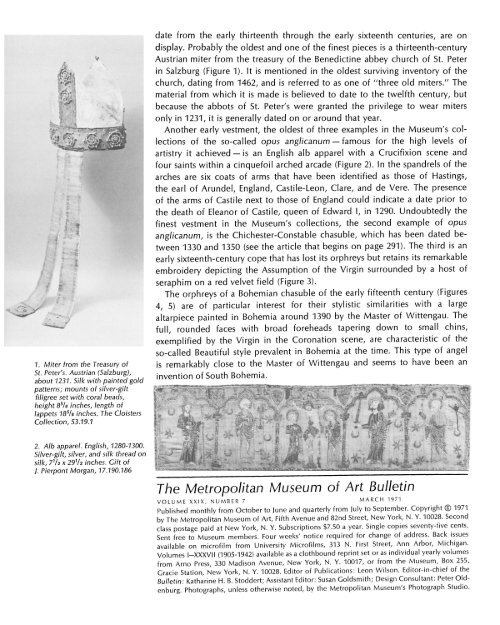The Metropolitan Museum of Art Bulletin, v. 29, no. 7 (March, 1971)
The Metropolitan Museum of Art Bulletin, v. 29, no. 7 (March, 1971)
The Metropolitan Museum of Art Bulletin, v. 29, no. 7 (March, 1971)
Create successful ePaper yourself
Turn your PDF publications into a flip-book with our unique Google optimized e-Paper software.
3r'i<br />
St. Peter's. Austrian (Salzburg),<br />
about 1231. Silk with painted gold<br />
patterns; mounts <strong>of</strong> silver-gilt<br />
filigree set with coral beads,<br />
height 85/8 inches, length <strong>of</strong><br />
lappets 185/8 inches. <strong>The</strong> Cloisters<br />
Collection, 53.19.1<br />
date from the early thirteenth through the early sixteenth centuries, are on<br />
display. Probably the oldest and one <strong>of</strong> the finest pieces is a thirteenth-century<br />
Austrian miter from the treasury <strong>of</strong> the Benedictine abbey church <strong>of</strong> St. Peter<br />
in Salzburg (Figure 1). It is mentioned in the oldest surviving inventory <strong>of</strong> the<br />
church, dating from 1462, and is referred to as one <strong>of</strong> "three old miters." <strong>The</strong><br />
material from which it is made is believed to date to the twelfth century, but<br />
because the abbots <strong>of</strong> St. Peter's were granted the privilege to wear miters<br />
only in 1231, it is generally dated on or around that year.<br />
A<strong>no</strong>ther early vestment, the oldest <strong>of</strong> three examples in the <strong>Museum</strong>'s collections<br />
<strong>of</strong> the so-called opus anglicanum - famous for the high levels <strong>of</strong><br />
artistry it achieved - is an English alb apparel with a Crucifixion scene and<br />
four saints within a cinquefoil arched arcade (Figure 2). In the spandrels <strong>of</strong> the<br />
arches are six coats <strong>of</strong> arms that have been identified as those <strong>of</strong> Hastings,<br />
the earl <strong>of</strong> Arundel, England, Castile-Leon, Clare, and de Vere. <strong>The</strong> presence<br />
<strong>of</strong> the arms <strong>of</strong> Castile next to those <strong>of</strong> England could indicate a date prior to<br />
the death <strong>of</strong> Elea<strong>no</strong>r <strong>of</strong> Castile, queen <strong>of</strong> Edward I, in 1<strong>29</strong>0. Undoubtedly the<br />
finest vestment in the <strong>Museum</strong>'s collections, the second example <strong>of</strong> opus<br />
anglicanum, is the Chichester-Constable chasuble, which has been dated between<br />
1330 and 1350 (see the article that begins on page <strong>29</strong>1). <strong>The</strong> third is an<br />
early sixteenth-century cope that has lost its orphreys but retains its remarkable<br />
embroidery depicting the Assumption <strong>of</strong> the Virgin surrounded by a host <strong>of</strong><br />
seraphim on a red velvet field (Figure 3).<br />
<strong>The</strong> orphreys <strong>of</strong> a Bohemian chasuble <strong>of</strong> the early fifteenth century (Figures<br />
4, 5) are <strong>of</strong> particular interest for their stylistic similarities with a large<br />
altarpiece painted in Bohemia around 1390 by the Master <strong>of</strong> Wittengau. <strong>The</strong><br />
full, rounded faces with broad foreheads tapering down to small chins,<br />
exemplified by the Virgin in the Coronation scene, are characteristic <strong>of</strong> the<br />
so-called Beautiful style prevalent in Bohemia at the time. This type <strong>of</strong> angel<br />
is remarkably close to the Master <strong>of</strong> Wittengau and seems to have been an<br />
invention <strong>of</strong> South Bohemia.<br />
2. Alb apparel. English, 1280-1300.<br />
Silver-gilt, silver, and silk thread on<br />
silk, 7/2 x <strong>29</strong>1/2 inches. Gift <strong>of</strong><br />
J. Pierpont Morgan, 17.190.186<br />
<strong>The</strong> <strong>Metropolitan</strong> <strong>Museum</strong> <strong>of</strong> <strong>Art</strong> <strong>Bulletin</strong><br />
VOLUME XXIX, NUMBER 7 MARCH <strong>1971</strong><br />
Published monthly from October to June and quarterly from July to September. Copyright <strong>1971</strong><br />
by <strong>The</strong> <strong>Metropolitan</strong> <strong>Museum</strong> <strong>of</strong> <strong>Art</strong>, Fifth Avenue and 82nd Street, New York, N. Y. 10028. Second<br />
class postage paid at New York, N. Y. Subscriptions $7.50 a year. Single copies seventy-five cents.<br />
Sent free to <strong>Museum</strong> members. Four weeks' <strong>no</strong>tice required for change <strong>of</strong> address. Back issues<br />
available on micr<strong>of</strong>ilm from University Micr<strong>of</strong>ilms, 313 N. First Street, Ann Arbor, Michigan.<br />
Volumes I-XXXVII (1905-1942) available as a clothbound reprint set or as individual yearly volumes<br />
from Ar<strong>no</strong> Press, 330 Madison Avenue, New York, N. Y. 10017, or from the <strong>Museum</strong>, Box 255,<br />
Gracie Station, New York, N. Y. 10028. Editor <strong>of</strong> Publications: Leon Wilson. Editor-in-chief <strong>of</strong> the<br />
<strong>Bulletin</strong>: Katharine H. B. Stoddert; Assistant Editor: Susan Goldsmith; Design Consultant: Peter Oldenburg.<br />
Photographs, unless otherwise <strong>no</strong>ted, by the <strong>Metropolitan</strong> <strong>Museum</strong>'s Photograph Studio.

















